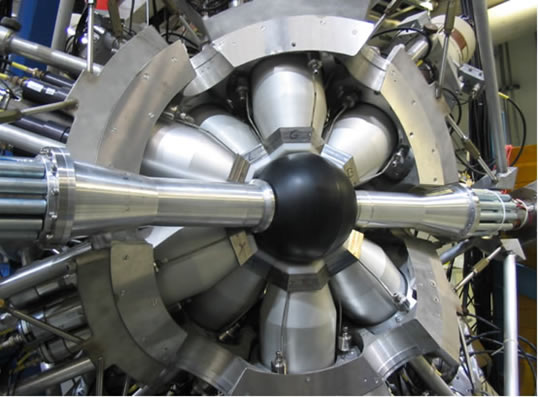THE 8Π SPECTROMETER AT TRIUMF
An array for high precision superallowed Fermi beta decay studies
The 8pi spectrometer, build in 1985 by a team of Canadian physicists, consists of 20 High Purity Germanium (HPGe) detectors used to measure very precisely the energy of one or more gamma-rays emitted by a decaying nucleus. Shown below is one half of the 8pi array. At the center of the array you can see SCEPTAR’s vacuum chamber.

Fig. 1: Half of the 8pi spectrometer with the SCEPTAR vacuum chamber. The beam is coming from left.
SCEPTAR (SCintillating Electron Positron Tagging ARray) consists of 20 plastic organic scintillators surrounding the beam deposition site. These scintillators are used to detect beta and positron emissions from decaying nuclei. An in-vacuum tape-transport system is used for the removal of long-lived activities, and the ability to precisely control the duration and frequency of the beam spills, tape movements, and counting times.

Fig. 2: The 8pi spectrometer, SCEPTAR and the moving tape system. Randy is setting up the array for an experiment.
Other auxiliary detectors used in conjunction with the 8pi include: 10 BaF2 detectors (Dipentagonal Array for Nuclear Timing Experiments doubt DANTE) for gamma-ray detection for fast-timing measurements and 5 Si(Li) detectors (Pentagonal Array for Conversion Electron Spectroscopy doubt PACES) for conversion electron spectroscopy.
Examples of experiments performed with the 8pi spectrometer
A key element of the 8pi program is superallowed Fermi beta decay studies with the non-accelerated radioactive beams from ISAC, which leads to precision tests of the validity of the Standard Model (SM). The SM predicts a set of rules which specifies the basic constituents of our Universe and the forces that act between them. At ISAC, studies of the decay of radioactive isotopes are being pursued to obtain a better understanding of these fundamental forces in nature. Most radioactive isotopes decay by the simultaneous emission of two energetic particles a beta (i.e. an electron) and a neutrino. Our present understanding of the weak interaction (the force that causes nuclear beta decay) predicts that for a very few special isotopes the decay properties should be identical and related in a simple way to the vector component of the weak force. Precision measurements of the decay rate for these so-called superallowed Fermi beta decays can be used to test this hypothesis and to determine the strength of the force. The current world data on superallowed Fermi beta decay leads to a result that provides one of the most precise tests of the Standard model. However, this result also depends on small but very important corrections that must be computed before the test can be applied. The TRIUMF-ISAC facility provides beams of these special radioactive isotopes over a wider mass range than was previously available. This allows us to further test the model and to validate the corrections that must be applied.
A radioactive beam of about 2000 62Ga particles per second with an kinetic energy of 30 keV was delivered by ISAC. The beam particles were implanted in the moving system placed in the middle of the array shown above. Data was collected in cycles consisting of 2 seconds of background counting (beam off), a 10 second beam on period during which the 62Ga activity quickly saturated, and 2 seconds of decay with beam off. The tape was moved every 14 s to prevent the build-up of longer-lived contaminants such as 62Cu and 62,62mCo, which can be also produced. This cycle was repeated about 20,000 times. The beta particles were detected in SCEPTAR while the gamma-rays by the 8pi spectrometer. By selecting coincidences between the gamma-ray and the beta particles, 19 new gamma-ray transitions following the beta decay of 62Ga into 62Zn have been identified. The superallowed Fermi branching ratio has been determined as 99.861(11)% and represents the first high-precision value in the A>62 region. It simply helps scientist to refine their theoretical models on fundamental symmetries.

Fig. 3: Number of counts (about 2.1 x 108 62Ga decays) as a function of time (0.1 s/channel) from SCEPTAR. Note the cycle described in the text (cycle 2s/10s/2s). The negative slope is due to 62Cu contaminant.

Fig 4: 62Zn level scheme deduced from this experiment.
The 8pi collaboration
C. Andreoiu, D. Cross (Simon Fraser University), R. A. E. Austin, A. Chaffey, R. Kanungo (St Mary’s), G.C. Ball , D. Bandyopadhyay, P. Bricault, J. Daoud, M. Dombsky, K. Foster, G. Hackman, A. C. Morton, C. J. Pearson, S. Williams (TRIUMF), G. Demand , P. Finlay, P.E. Garrett , G.F. Grinyer , K. L. Greene , K. G. Leach, M. A. Schumaker, A.A. Phillips, C.E. Svensson, J. Wong, S. Triambak, C. Sumithrarachchi (University of Guelph), D. Kulp, J. Wood, (Georgia Tech), J. R. Leslie, I.S. Towner (Queens University), D. Melconian (Texas A&M), C. M. Mattoon, F. Sarazin (Colorado Schools of Mines), W.E. Ormond (Lawrence Livermore National Lab), E.F. Zganjar (Louisiana State University)
8pi recent experimentsE1028 26mAl lifetime measurement at GP1
E1028 26mAl branching ratio with the 8pi
E823 74Rb branching ratio measurement with the 8pi
E961 70Br and 66As lifetimes at GP1 and branching ratio with the 8pi
E1040 Lifetimes of 10C and 14O at GP1 and 8pi
E1137 Lifetimes and branching ratios for 50Mn and 46V
Most recent publications
Half-life of the superallowed beta+ emitter 18Ne
G. F. Grinyer et al. Phys. Rev. C 76, 025503 (2007)
Beta decay of 32Na
C. M. Mattoon et al. Phys. Rev. C 75, 017302 (2007)
Precision Branching Ratio Measurement for the Superallowed Beta+ Emitter 62Ga and Isospin-Symmetry-Breaking Corrections in A 62 Nuclei
B. Hyland et al. Phys. Rev. Lett. 97, 102501 (2006)
High precision measurements of 26Na beta– decay
G. F. Grinyer et al. Phys. Rev. C 71, 044309 (2005)


